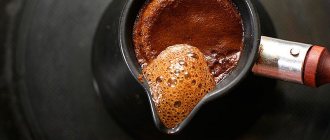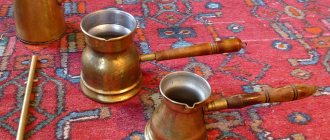Coffee has been known in Turkey since the times of the Ottoman Empire, and today it is drunk not only in this country, but throughout the world. This is an important part of the local national culture, a drink that is served at all important events, including bride's viewings, and is also drunk just like that - for pleasure after a hearty meal. You can easily make Turkish coffee in a Turk at home - you need a minimum of equipment or utensils and ingredients. You will succeed!
Turkish drink review
Turkish coffee is the national drink of Turkey, which has gained worldwide popularity thanks to its exquisite taste and fantastic aroma. Basically, Turkish coffee is prepared according to a recipe that is easy to prepare, but at the same time has its own secrets and important nuances.
Turkish coffee first appeared in the 16th century under Sultan Suleiman the Magnificent and was served only in the highest circles of the nobility. Later, the first coffee shops began to appear in 1564 in the city of Istanbul. There are many rituals and traditions associated with coffee in Turkey. Drinking coffee together was considered a sign of respect and friendship. Coffee houses were where people liked to spend time during the day socializing, playing chess, discussing politics, etc.
Vessel selection
The most important thing when choosing a Turk is the conical shape and small volume of the container. The most common type of Turk for making coffee is the metal Turk.
This Turk is very easy to use, durable and easy to handle. Metal Turks are made of aluminum, silver, copper and stainless steel.
Among these four types of material, stainless steel and aluminum pots are the worst options to purchase, as the coffee in them will be worse in taste and consistency.
Silver and copper Turks are the best options for both the aesthetic and functional aspects of making Turkish coffee. However, the best coffee is obtained from a copper pot.
Due to the fact that copper has high thermal conductivity, the Turk heats up evenly and this contributes to the correct technology for preparing the drink. At the same time, it is necessary that the bottom of the Turk be covered with tin, because copper can release substances harmful to the human body.
In addition to metal ones, there are other types of Turks that are less commonly found on sale, but are also traditionally used for making Turkish coffee. For example, ceramic Turks are characterized by thick walls that retain heat and are of good quality.
Much less common are Turks made from Yixing clay, which enriches coffee with oxygen due to its porous structure. However, such Turks are very fragile and may not last long.
When buying a Turk, the professional advice in the video will help you:
How to choose coffee?
The best type of coffee is Brazilian Arabica. You need to buy coffee in beans and grind it yourself before the brewing process as finely as possible, literally into dust.
There is also Luwak coffee, a very specific coffee according to the method of its preparation, which is very original, but at the same time recognized as the most expensive and delicious type of coffee in the world.
What types of coffee are there and how to choose the right one, you will learn from the video:
How much water do you pour?
Cold drinking water is poured to the level of the neck of the Turks. It is necessary to achieve minimal contact with air to fully saturate the drink with the aroma and taste of coffee beans.
Sand
Sand is used to create uniform heating throughout the Turk. This coffee is prepared in a specialized roaster, onto which sand is poured.
It is better to choose quartz sand, as it is the finest sand and is ideal for making coffee.
A Turk is placed on top, and then the coffee is prepared by analogy with the classic recipe.
Turkish coffee: TOP 8 popular brands
Kurukahveci Mehmet Efendi Türk Kahvesi
In the 19th century, Turkish coffee was sold in beans that customers roasted and ground themselves by hand. In 1871, Mehmet Efendi, who inherited the business from his father, made a name for himself by starting to sell it already ground, causing the streets of Istanbul to be filled with a new aroma.
Today, Kurukahveci Mehmet Efendi brand coffee is not just among the leaders, but No. 1 in Turkey.
Price per 100 g: about 5 rounds. lira (or at the exchange rate of about 80 rubles).
Nescafe
This brand needs no introduction, because the whole world is entangled in its coffee chains. In today's crazy pace of life, an instant instant drink has become an unconditional alternative to the traditional “get-together” drink.
In the minds of the Turks, the name of the Nescafe brand over the many years of its existence on the Turkish market has become so closely intertwined with the concept of instant coffee that it has become a household name, like, say, “copier”.
Price per 100 g: 15 – 30 round. lira (240-480 rub.).
Jacobs Monarch
The German brand, which appeared on the Turkish market in 1995 with instant and filtered coffee, has strengthened its position and won the love of Turkish coffee lovers thanks to its excellent taste and aroma. Which, in principle, is not surprising, that’s why he’s German.
Price per 100 g: 15 – 30 round. lira (240-480 rub.).
Kahve Dunyası Türk Kahvesi
The Istanbul-based company, which opened its first coffee shop in 2004, quickly achieved a level of fame where the brand name is passed on by word of mouth with accompanying praise.
The fame of Kahve Dünyası coffee has spread far beyond the country, thanks to the opening of stores in England, Romania, Saudi Arabia and Kuwait.
Unlike many other Turkish manufacturers, this company, in addition to ground Turkish coffee, also produces filtered and instant coffee.
Price per 100 g: 5 – 7 round. lira (80-112 rubles).
QUESTION FOR RELEASE: WHO INVENTED THE FAMOUS ALL INCLUSIVE SYSTEM?
Hint: he is Turkish. But still no one has answered
If you are the only one or the only one who knows, write to the author of the site, he is eager to meet you.
If not, just read the article about this Great Man and his Fate at the link.
Hisar Kahve 1928
The company, which began its existence in 1928 from a small coffee shop, uses the experience of generations and modern technologies to create a traditional Turkish drink.
According to the manufacturer of the Hisar Kahve 1928 brand, in the very near future they plan to gain the preferences of coffee fans in an unprecedented way not only in Turkey, but also abroad.
Let's see how it works out for them.
Price per 100 g: 5 – 7 round. lira (80-112 rubles).
Cezbeli kahve
Despite its relatively young age, only 8 years, this Istanbul brand has already gained a reputation for quality coffee, thanks to the manufacturer’s use of only ideal Arabica beans, as stated on the packaging “100% Arabica”.
Portion bags will allow you not to part with your favorite taste for a minute.
Price per 100 g: 5 round. lira (80 rubles).
Nurettin Kocatepe Türk Kahvesi
The coffee business, which began in Ankara as an adventure, led to the creation in 1949 of an entire company called Kocatepe 1949, which combined the accumulated knowledge and experience to improve the quality of its products.
The promising motto is especially pleasing.
Nurettin Kocatepe brand coffee, despite the intense roasting of the beans, has a mild taste that evokes conflicting emotions among lovers of the classics.
Price per 100 g: 5 – 7 round. lira (80-112 rubles).
How to cook in a Turk?
Mehmet Efendi is a large Turkish coffee producer with a famous name and rich history. How to brew Turkish coffee in a Turk - is it a vessel in which Turkish coffee is brewed? To prepare Turkish coffee in a Turk according to Mehmet Efend's recipe, you will need the following.
- water150ml.
- ground coffee 2 hours l.
- sugar to taste
Cooking method:
- Pour all the ingredients into the Turk. Brew coffee over low heat, stirring constantly.
- After raising the coffee level a second time, you can divide it into two halves and pour ½ of the drink into a coffee cup.
- The second half needs to be cooked for another half a minute and poured into a cup along with the coffee grounds. In half a minute the grounds will settle.
- Traditionally, Turkish coffee is served with a glass of water.
How to brew coffee according to Mehmet Efendi’s recipe, watch the video:
Which coffee to choose
Now let’s choose what kind of coffee we will brew:
- Classic Turkish coffee - double roasted and finely ground. The best coffee brands: Mehmet Efendi - double roasted, strong. Billur - I have only encountered this coffee in the shops/markets of Cappadocia, it has a harsher taste, stronger roast, the Turks love it. Kocatepe - the taste is a little softer than the brands above, I liked it.
- Kahve dünyası / orta kavrulmuş / medium roast. Also softer, grind just as fine.
- Menengich coffee is an alternative to classic coffee; I would say it is a coffee drink that does not contain caffeine, but contains a large amount of tannin. The taste and aroma are divine, the nut-milk aftertaste cannot be compared with anything! These are the fruits of the turpentine tree from the genus Pistachio.
- Dibek coffee is a mixture of coffee, cardamom, cocoa fruit, sahleb (orchid tuber powder), and sometimes carob powder is added, and pure cream is added to soften the spicy taste.
General Tips
- Follow the grinding technology. If the coffee grinder is used incorrectly, grinding the beans for too long can cause overheating, causing the taste to deteriorate.
- Store coffee in a dry, airtight container.
- Take out the coffee only with a dry, clean spoon.
- Rinse the Turk thoroughly after washing to avoid any detergent residue.
- Brew coffee strictly before serving, as it can cool and lose its properties, taste and aroma.
- Roasted grains are stored for no more than 2 weeks, since after this period they lose their aroma and flavor richness.
- The foam that appears on the surface of the drink when heated must be intact and without cracks.
- You should not allow the coffee to boil, you just need to wait until the foam rises up to 2 times and then immediately pour it into a cup.
The process of preparing Turkish dishes is not complicated, you will see this if you try to cook dishes such as güvec, babaganush or Turkish eggplant.
How the recipe came about
The history of this recipe does not begin in Turkey. Caravan workers in North America and Asia were the first to brew coffee using this technology. To deliver the cargo, they had to move through deserts and mountains for several months. Wanting to replenish their strength, they brewed coffee beans. They prepared the drink on hot sand near the fire, periodically moving the container closer to the fire to maintain the desired temperature.
After a while, the Turks learned about this recipe. It gained immense popularity in the East, and soon Turkish coffee became famous throughout the world.
What to add?
You can vary your coffee preparation by adding cream or milk.
It has been very popular in coffee shops lately to serve coffee with syrups for every taste and color. Such options are very different from the original, but in order to please visitors, Turkish coffee can also offer completely unusual serving options with whipped cream and mashmallows, which is a very popular option today.
The coffee aroma, according to Turkish residents, is enhanced by adding a small amount of salt before serving.
For lovers of Turkish cuisine, several recipes for delicious dishes are offered: imam bayaldi, gubadia, achma, lahmacun, kufta.
Story
The official history of Turkish coffee dates back to the 16th century, when the drink began to be served in coffee shops in Istanbul. Very soon, such establishments became cultural centers, where men gathered to spend the evening talking, discussing the latest news and art, and playing backgammon.
According to legend, Syrian traders brought coffee to Turkey in 1555.
The invigorating drink played such an important role in the cultural and social life of society that the wives and concubines of the Sultan in the harem were required to take a course in the correct preparation of coffee. Women of lower rank also mastered this art with might and main - the more delicious a girl made coffee, the more chances she had to get married successfully.
Echoes of this tradition have survived to this day: when the groom’s parents come to the house of the bride’s parents to ask for her hand in marriage, the girl must personally brew coffee for the guests.
Coffee grounds will predict the future
The magic of brewing coffee with sand doesn't end when the cup is empty. Now you can tell your fortune. While drinking a cup of drink, it is worth thinking about the question to which you want to get an answer.
When only the thick remains at the bottom, you should wait until it thickens a little. Now you need to concentrate and cover the cup with a saucer, then with a sharp movement turn the structure over. Next, the imagination should suggest what the coffee grounds spreading over the saucer show.
You can guess at the grounds only if the drink is drunk without additives, and it is better not to even add sugar.
LiveInternetLiveInternet
Coffee is a very famous international drink that is often ordered in cafes, restaurants and shops. For many, morning coffee is a vital act; for others, it is an act of meditation. Of course, you can prepare a tasty and aromatic drink in a modern coffee machine, and we will prepare coffee in a Turk using the best methods and recipes.
Secrets: how to brew ground coffee in a Turk
In order for Turkish coffee to turn out perfect, you need to know some of the nuances of preparing this amazing drink at home:
The main condition is gradual heating.
It is important that when the temperature rises, it does not exceed the norm, otherwise the drink may “run away” or lose its aroma.
Strong fire and delicious coffee are two incompatible criteria.
For the best taste, you need to use soft and clean water. In addition, just like the finished drink, it cannot be brought to a boil, this will only spoil the coffee.
Finely grinding the seeds will give the drink a bright aroma and make it richer.
It is best to grind coffee beans immediately before brewing, since they lose their valuable qualities during long-term storage.
It is important to maintain proportions; you should not put more grains than normal, as this may cause the finished drink to taste bitter.
If you add a pinch of salt to the bottom of the Turk, this will give the drink a more distinct aroma. There is no need to be afraid that it will acquire a salty taste.
Before serving the drink, you need to warm the cups so that it remains aromatic longer.
In order to prevent grounds from getting into the cup, before serving, pour a teaspoon of cold water into the Turk or tap it twice on the edge of the table.
How to brew coffee with foam on the stove
Everyone knows that the most delicious coffee is with foam. But how to preserve it and enjoy the unsurpassed aroma? First of all, you need to choose a quality Turk. A significant difference between the size of the base and the neck will provide a dense and rich foam. But the cooking process in this case also requires special attention, because the foam will rise rapidly.
Ingredients:
filtered (bottled) water – 100 ml;
finely ground coffee beans – 1-2 tsp;
cane sugar – 1 tsp.
Cooking method:
Pour ground grains into the cezve, add sugar, add cold water at the end, and then put the cezve on low heat. After some time, foam will begin to appear on the surface, which will darken and rise in the process. The main thing here is not to “miss it”! When the foam reaches the edges of the turk (but does not spill over the edge), the cezve must be removed from the heat, let the foam settle a little, and then repeat the process “until boiling” again, and so on 3-5 times. At the same time, it is important to preserve the foam layer, since it acts as a kind of lid under which the drink languishes. If there is no foam left on the surface of the coffee, it will simply boil with bubbles, and you will miss the opportunity to enjoy the special taste and aroma
Brewing natural coffee with cinnamon in a Turk
Cinnamon gives coffee a richer taste, tones and reduces appetite.
Ingredients:
finely ground coffee beans – 1 tsp;
water – 100 cl; sugar – 1/3 tsp;
cinnamon – 1/3 tsp.
Cooking method:
All ingredients need to be poured into a Turk and carefully heated over the fire (without water!). Then add water, put the cezve on the stove and wait for the coffee to start boiling. When the first signs of “revival” appear, i.e. After boiling the drink, you need to pour a little coffee into a pre-prepared cup and put the Turk back on the fire. Repeat this ritual 3-4 times, after which you can enjoy the aromatic drink.
How to make espresso correctly
In order to brew real espresso, you need a coffee machine, but what about those who don't have one? You can try cooking it in a Turkish coffee pot, but the taste will be very different from that brewed in a coffee maker.
Ingredients:
finely ground coffee beans – 2 tsp;
water – 60 ml; sugar - to taste.
Cooking method:
Add coffee to the Turk, slightly heat the contents of the cezve over the fire, if you like sweet coffee, then you need to add sugar now. Then pour in boiled and cooled water to 40°C. As soon as the drink starts to boil, immediately remove the Turk from the heat, stir and put it back on the stove until it boils. Then pour into a cup and cover with a lid for one minute.
Brewing coffee beans with milk
Coffee beans with milk are light and pleasant in taste, as well as thick in consistency. Let's consider two options:
Ingredients:
finely ground coffee – 1-2 tsp; milk – 50 ml.
Recipe No. 1: Pour milk into the cezve and heat it to 40-50°C. Add ground grains to warm milk and put the Turk on the fire. When the drink reaches a boil, you need to set the cezve aside for a while, then repeat the “until boiling” process twice. This preparation option gives the drink a soft, unsweetened taste and a hint of chocolate.
Recipe No. 2: Pour ground grains into the cezve, then fry it a little over low heat for one minute. Pour milk preheated to 35-40°C on top. Bring the contents of the cezve to a boil and set aside for a while, then repeat the process “until boiling” twice.
This method gives the drink a light aroma and a coconut tint.
Both of these recipes will allow you to experience your unique range of tastes and aroma of coffee beans with milk. One way or another, you can be sure that it will be really tasty.
Turkish cooking method (video)
Ingredients:
ultra-fine ground coffee beans – 25 g;
filtered water – 150 ml;
sugar - to taste; cardamom - to taste.
Cooking method:
Fill the Turk with water at room temperature, add ground grains. If you like sugar and cardamom, you can add these ingredients to the contents of the turk and stir thoroughly until a paste forms. Then put the cezve on the fire. Wait until the foam reaches the edges, then remove the Turk from the stove and pour the foam into a previously prepared cup. Repeat the “until boiling” process twice, the third time remove the drink from the stove, leave for two minutes, then carefully pour the drink into a cup. That's all, but in order to consolidate this recipe in your memory, I suggest watching the following video.
Interesting Facts
- Nowhere in the world do coffee shops play such a significant role as in Turkey. It is interesting that they are still predominantly attended by only men, and women prefer to visit each other.
- Turks sweeten their coffee at the preparation stage, adding sugar directly to the cezve, and never to the cup.
- In 2013, Turkish coffee was included in the UNESCO World Heritage List.
- The type of coffee does not matter - Turks readily drink both Arabica and Robusta or their blends. The main thing is that the grains are ground as finely as possible and boiled in a cezve.
- Despite the fact that “Turkish coffee” has already become a household name and is deeply integrated into the culture of the country, the Turks themselves still drink tea more often.
Author of the article: Diana Koltsova
barista and coffee lover rolled into one
Your mark:











